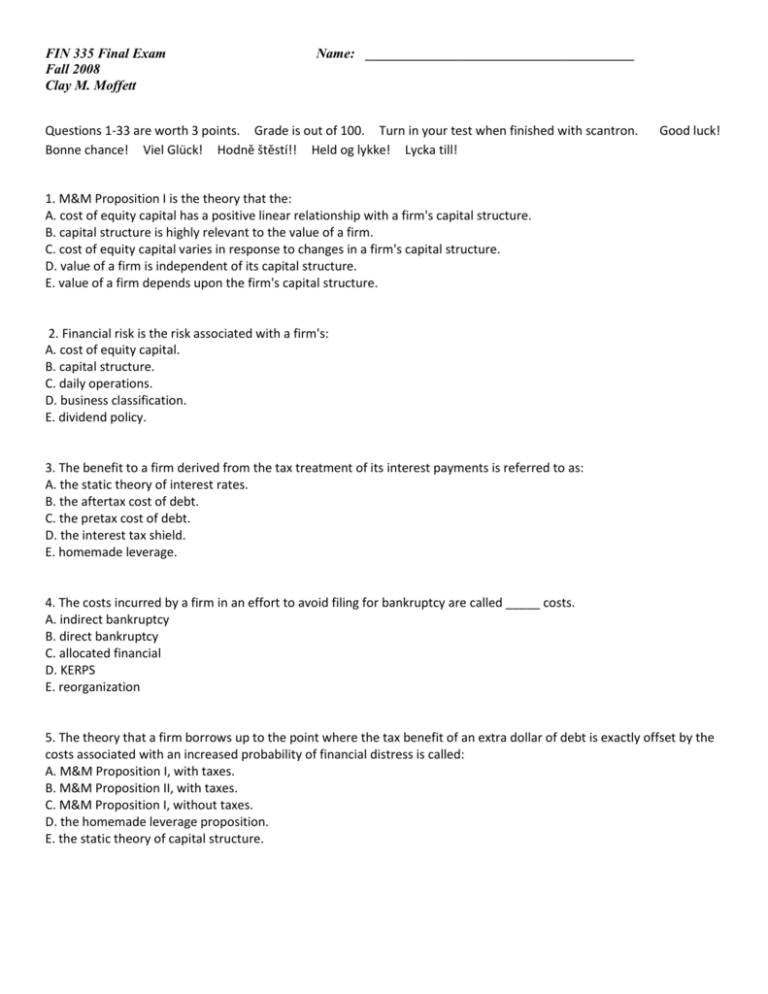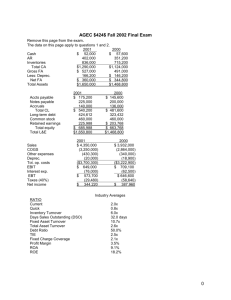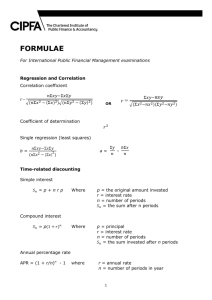Sample Final Chp 13
advertisement

FIN 335 Final Exam Fall 2008 Clay M. Moffett Name: _______________________________________ Questions 1-33 are worth 3 points. Grade is out of 100. Turn in your test when finished with scantron. Bonne chance! Viel Glück! Hodně štěstí!! Held og lykke! Lycka till! Good luck! 1. M&M Proposition I is the theory that the: A. cost of equity capital has a positive linear relationship with a firm's capital structure. B. capital structure is highly relevant to the value of a firm. C. cost of equity capital varies in response to changes in a firm's capital structure. D. value of a firm is independent of its capital structure. E. value of a firm depends upon the firm's capital structure. 2. Financial risk is the risk associated with a firm's: A. cost of equity capital. B. capital structure. C. daily operations. D. business classification. E. dividend policy. 3. The benefit to a firm derived from the tax treatment of its interest payments is referred to as: A. the static theory of interest rates. B. the aftertax cost of debt. C. the pretax cost of debt. D. the interest tax shield. E. homemade leverage. 4. The costs incurred by a firm in an effort to avoid filing for bankruptcy are called _____ costs. A. indirect bankruptcy B. direct bankruptcy C. allocated financial D. KERPS E. reorganization 5. The theory that a firm borrows up to the point where the tax benefit of an extra dollar of debt is exactly offset by the costs associated with an increased probability of financial distress is called: A. M&M Proposition I, with taxes. B. M&M Proposition II, with taxes. C. M&M Proposition I, without taxes. D. the homemade leverage proposition. E. the static theory of capital structure. 6. A taxpaying, levered firm's optimal capital structure: A. is 100 percent equity financing. B. consists of equal amounts of debt and equity financing. C. is the mixture of debt and equity financing that minimizes the firm's aftertax cost of debt. D. is the mixture of debt and equity financing that minimizes the weighted average cost of capital. E. is 100 percent debt financing. 7. Which one of the following occurs if a firm files for Chapter 7 bankruptcy but does not generally occur if the firm files for Chapter 11 bankruptcy? A. a petition is filed in federal court B. administrative fees are incurred C. a list of creditors is compiled D. pre-bankruptcy shareholders tend to lose part, if not all, of their investment in the firm E. a trustee-in-bankruptcy is elected by the creditors 8. Birchwood Cabinets has 12,000 bonds outstanding with a face value of $1,000 each. The coupon rate is 8 percent and the tax rate is 35 percent. What is the present value of the interest tax shield? A. $.34 million B. $2.76 million C. $4.20 million D. $18.41 million E. $34.29 million 9. A firm has a cost of debt of 8 percent and a cost of equity of 15.5 percent. The debt-equity ratio is .6. There are no taxes. What is the firm's weighted average cost of capital? A. 11.97 percent B. 12.49 percent C. 12.69 percent D. 12.90 percent E. 13.10 percent 10. You are comparing two possible capital structures for a firm. The first option is an all-equity firm. The second option involves the use of $1.5 million of debt. The break-even point between these two financing options occurs when the earnings before interest and taxes (EBIT) are $230,000. Given this, you know that leverage is beneficial to the firm: A. whenever EBIT is less than $230,000. B. only when EBIT is $230,000. C. whenever EBIT exceeds $230,000. D. only if the debt is decreased by $230,000 to a total of $1.27 million. E. only if the debt is increased by $230,000 to a total of $1.73 million. 11. The declaration date is the date: A. a dividend is announced to the general public. B. on which a shareholder must be a recorded owner to receive the dividend. C. dividend payments are distributed to shareholders. D. by which shares must be purchased to receive the dividend. E. the board of directors passes a resolution to pay a dividend. 12. Which one of the following increases the number of shares outstanding without increasing the value of the owners' equity? A. stock repurchase B. reverse stock split C. stock split D. cash distribution E. liquidating dividend 13. Monday, July 16, is the ex-dividend date on Baker Foods, Inc. stock. Which one of the following dates is the record date? Assume there are no banking holidays to consider. A. Wednesday, July 11 B. Thursday, July 12 C. Friday, July 13 D. Wednesday, July 18 E. Thursday, July 19 14. Dividend policy: A. is based on the theory that a $1 dividend next year is worth as much as a $1 dividend today. B. ignores the time value of money. C. addresses the timing of dividend payments. D. enables a firm to increase the current dividend without affecting any future dividends. E. is highly relevant. 15. Copper Products has common stock outstanding at a market price of $68 a share. The total market value of the firm is $2,584,000. Tomorrow, the firm is finalizing a liquidation of one of its units, which has a total market value of $950,000. The firm plans on distributing the entire proceeds from the liquidation to shareholders. What will the amount of the liquidation dividend be per share? A. $25.00 B. $26.75 C. $27.50 D. $28.20 E. $30.00 16. A regular cash dividend is best described as a: A. distribution by a firm to its shareholders. B. payment from any source by a firm to its owners. C. one-time payment of cash by a firm to its shareholders. D. cash payment by a firm to its owners as part of a firm's normal operations. E. distribution of the proceeds from the sale of a portion of a firm's operations. 17. Which one of the following is a non-cash payment made by a firm to its shareholders that dilutes the value of each share of stock outstanding? A. reverse stock split B. cash distribution C. stock dividend D. regular dividend E. liquidating dividend 18. Which one of the following situations is most apt to result in a special dividend payment? A. Gulf Port Marina recently sold its facility and is closing down the company. B. San Francisco Tours currently has excess cash that it wishes to distribute to its shareholders. This occurs every so often and when it does, the firm prefers to pass the extra cash along to its shareholders. C. Northern Electric is planning to increase its quarterly dividend by two percent. D. F&D Florists is preparing to pay its first annual dividend of $.20 a share. E. Gibson Toys was fortunate this year in that it developed a new toy that broke all previous toy sale records. The profits from this toy were phenomenal but the company realizes that the odds of this type of luck reoccurring are slight, at best. 19. A firm currently has an average tax rate of 20 percent and a marginal tax rate of 25 percent based on its current taxable income of $36,500. What will the firm’s average tax rate be if it increases its taxable income by $1,200? a. 20 percent b. 22.05 percent c. 22.54 percent d. 20.15 percent 20. In Canada and the United Kingdom, a perpetuity is also called a(n): a. consul. b. infinite bond. c. infinity flow. d. dowry. e. forever bond. 21. Which one of the following is a breakdown of the ROE into its three component parts? a. Du Pont decomposition b. efficiency breakout c. equity analysis d. sustainable growth e. profitability ratios 22. Which one of the following formulas is correct? a. Profit margin = EBIT / Sales b. Capital intensity ratio = 1 / Return on assets c. ROA = ROE / Equity multiplier d. Quick ratio = Cash / Current liabilities 23. When a bond's yield to maturity is greater than the bond's coupon rate, the bond: a. will be called. b. is selling at a premium. c. has reached its maturity date. d. is priced at par. e. is selling at a discount. 24. A 6 percent $1,000 bond matures in 4 years, pays interest semiannually, and has a yield to maturity of 8.70 percent. What is the current market price of the bond? a. $768.76 b. $801.38 c. $869.15 d. $910.27 e. $970.69 25. The price of a stock at year 5 can be expressed as: a. P0 g5. b. D0 (1 + R)5. c. P1 (1 + R)5. d. D6 / (R g). e. D5 / (R g). 26. What is the net present value of a project with the following cash flows if the discount rate is 10.2 percent? a. $1,048.31 b. $1,193.77 c. $3,498.28 d. $4,102.86 e. $4,513.15 27. You are considering the following two mutually exclusive projects. The required return on each project is 11 percent. Which project should you accept and what is the best reason for that decision? a. Project A; because it pays back faster b. Project A; because it has the higher profitability index c. Project B; because it has the higher profitability index d. Project A; because it has the higher net present value e. Project B; because it has the higher net present value 28. The variance is the: a. difference between the actual return and the average return. b. difference between the actual return and the average return divided by N 1. c. average squared difference between the actual return and the average return. d. average squared difference between the actual return and the average return divided by N e. square root of the standard deviation. 1. 29. The return on which one of the following is used as the risk-free rate of return? a. long-term corporate bonds b. long-term government bonds c. short-term corporate bonds d. U.S. Treasury bills e. the Consumer Price Index 30. One year ago, you bought a stock for $21.40 a share. You received a dividend of $1.90 per share last month and sold the stock today for $19.80 a share. What is the capital gains yield on this investment? a. 8.08 percent b. 7.48 percent c. 5.47 percent d. 1.40 percent e. 1.52 percent 31. Systematic risk is: a. a risk that affects a large number of assets. b. the total risk inherent in an individual security. c. also called diversifiable risk. d. also called asset-specific risk. e. unique to an individual firm. 32. The equation that is represented graphically by the security market line is called the: a. capital market function. b. portfolio diversification model. c. bell curve. d. capital asset pricing model. e. market risk model.





